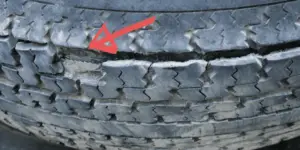Driving a car can be a necessity or a thrill, depending on if it is for work or pleasure. Either way, when it starts to feel loose, it can quickly become dangerous, whatever reason you are driving for.
This article will discuss why your car feels loose while driving and ways to overcome this problem. You’ll also get to know why your car feels shaky and unresponsive on the road.
In brief,
If your car feels loose while driving, there is a possibility of a broken steering linkage or poor suspension, including alignment, wheel balancing, wheel bearings, and worn-out tires.
Now onto the details:
4 Reasons Your Car Feels Loose While Driving
Broken Steering Parts
After brakes, your steering is the most important component of your car. When it feels loose, it’s time to take matters seriously and investigate further.
To understand the functioning of steering, let us mention three of its main components; steering rack/ box, linkages, and front suspension.
Why does a steering wheel loosen itself?
It is due to looseness in the steering gear or linkage components of the steering wheel. The steering rack is connected to the front wheels and helps move around the pivot.
A rack and linkage transfer rotational force from the steering wheel to the front wheels. If the linkages are worn out, it causes the steering to be sloppy and vague.
How to know if my steering linkage is worn?
Well, there are a lot of joints in the steering system, and they eventually wear out and become slack. Even a small looseness can manipulate the whole system.
For this, turn your steering left fully and slowly reverse the car. If it makes a clunking noise, the joints need to be repaired. Although you could drive a couple of thousand km more, it can affect other steering system parts once it breaks.
What makes the steering rack problematic?
It’s rare, but some cars steering racks need to be greased after a certain period. Also, you need to maintain the fluid level in the steering fluid bottle; otherwise, it will eventually cause wear on steering components and restrict flow, and thus your power steering system will start to lose effectiveness.
When to expect wear in the steering rack?
There is no specific time limit for it to wear out. A steering rack issue can happen at any time, which is more common on cars that do urban driving. Simply put, cars in this environment turn around corners more often than cars driven predominantly on the highway, so the parts wear more quickly.
Low or poor power steering fluid can also cause vague steering, especially at high speeds.
4 Signs of poor fluid include
1. Noise while moving the steering wheel
2. Metal flakes in power steering fluid
3. Hard steering
4. Steering symbol on the dashboard.
5. Dark brown fluid
Poor Wheel Alignment
Poor alignment can be the reason your car handling feels loose. This can feel like the car wandering all over the road, losing grip, and being less precise around corners.
What causes poor wheel alignment?
There are several reasons for poor alignment, as mentioned below
1. Having minor accidents
2. Driving over potholes/ bumpy roads
3. Frequently crossing speed bumps on high speed
4. Normal wear and tear can eventually cause your car to lose alignment.
How to know if I have loose alignment?
These are the signs that you need to have an alignment shortly.
1. The car moves in a straight line while the steering wheel is turned either left or right.
2. Your tire wear is uneven or worn out
3. Your tires are squealing i-e the sidewalls flex too much and cannot generate enough traction to turn the car smoothly
4. The car steering is aligned rightly but is either pulling the car towards the left or right side.
5. The steering makes noise often while turning.

How do I fix my alignment?
1. Check your tire pressure first. Uneven pressure can cause symptoms of poor alignment.
2. Inspect the front suspension components for wear and tear. They include ball joints, steering knuckles, springs, shocks, and tie rods. Get it repaired/ changed as needed.
3. Determine in-toe and out-toe to see whether the tires fall inward or outward. For this, measure the distance between the front and back tires, and if the distance is equal means zero toes. In some cases, a slight in-toe is recommended for improved stability.
In most cases, a quick visit to a tire shop will check this for you cheaply.
However, the different measurements of the distance between tires indicate an imbalance, and you can resolve it yourself. Locate the tie rods at the connection between your steering system and wheels. Rotate the tie rod to set toe-in and toe-out as per your need.
4. Take your car for a test drive; if the problem remains, see a professional mechanic.
More reading: Wheel Alignment Vs. Tire Balancing
Worn Out Tires
The tires are the simplest reason for your car’s instability and being loose. Yes, you heard it right! Good tires provide a better grip and play a role in keeping your car stable, firm, and safe.
How to know if my tire is worn?
You can identify a worn tire by looking at the tread. Inspect the depth of the patterns and blocks.
Also, look for cuts and cracks in the tire’s sidewalls and see if it can survive further or not.
When do I replace my tires?
New tire patterns have a depth of 8-9 millimeters. It can come down to 2 millimeters, but anything around 1.6 or less could be dangerous. Replace your tire before 2mm remains for safety and better road grip.
Wheel Bearings
The wheel bearing is an important component of your wheel that attaches the wheel to the axle. It enables smooth and firm wheel movement around the axle and levels of your ride.
How to know if wheel bearings are damaged?
Following are the symptoms of having a damaged wheel bearing
1. Your car will make a crumbling and grinding sound.
2. This will affect the durability of your tires.
3. You will feel a prominent vibration in the steering wheel, especially at high speeds. Also, the steering wheel will feel shaky and loose.
What causes damage to wheel bearings?
A damaged wheel bearing is caused by damage to the bearing seals, which paves the way for water, heat, and mud to enter the bearing and mix up with the grease inside, thus wearing it. It usually happens due to rash driving in mud/ water or extreme heat.
Can I drive my car with damaged bearings?
Yes, you can, but it’s not advised. You will find that they become noisier and can cause friction and heat up, affecting brakes.
How to fix my wheel bearings?
Changing your bearing is possible at home. Here are mentioned few steps to do so
1. Use a jack to lift your car from the side you want to repair
2. Remove the tire side causing the problem
3. Remove the outer wheel bearing using pliers
4. Remove the rotor and inner wheel bearing.
5. Rub the greasing into the casing
6. Put a new bearing at the back of the rotor
7. Push the bearing into the seal
8. Tighten the nut and turn the rotor counterclockwise simultaneously.
9. Put the brake rotors and tires back on.
10. You’re good to go.
In conclusion
Worn tires, steering linkage faults, or wheel alignment issues might be one of the reasons why your car’s steering feels sloppy or loose. This might be felt as a car drifting all over the road or feeling loose around bends.







![Car Wobbles At Low Speeds - [Troubleshooter Guide] inflating-tire-on-balancing-machine](https://carzaza.com/wp-content/uploads/2023/12/inflating-tire-on-balancing-machine-300x150.png)





